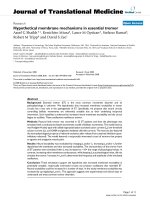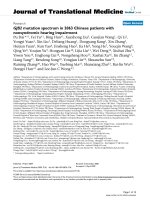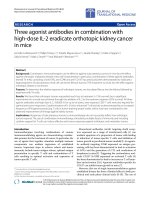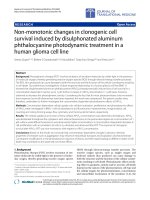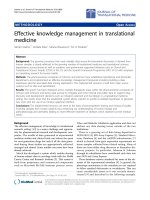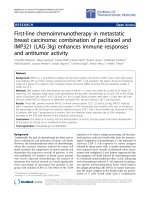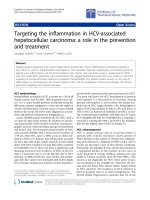Báo cáo hóa học: " Ultra-steep side facets in multi-faceted SiGe/Si(001) Stranski-Krastanow islands" pdf
Bạn đang xem bản rút gọn của tài liệu. Xem và tải ngay bản đầy đủ của tài liệu tại đây (686.41 KB, 8 trang )
NANO EXPRESS Open Access
Ultra-steep side facets in multi-faceted SiGe/Si(001)
Stranski-Krastanow islands
Moritz Brehm
*
, Herbert Lichtenberger, Thomas Fromherz, Gunther Springholz
Abstract
For the prototypical Ge/Si(001) system, we show that at high growth temperature a new type of Stranski-
Krastanow islands is formed with side facets steeper than {111} and high aspect ratio. Nano-goniome tric analysis of
the island shapes reveals the presence of six new facet groups in addition to those previously found for dome or
barn-shaped islands. Due to the highly multi-faceted island shape and high aspect ratio, the new island types are
named “cupola” islands and their steepest {12 5 3} side facet is inclined by 68°to the substrate surface. Assessing
the relative stability of the new facets from surface area analysis, we find that their stability is similar to that of
{113} and {15 3 23} facets of dome islands. The comparison of the different island shapes shows that they form a
hierarchical class of geometrical structures, in which the lower aspect ratio islands of barns, domes and pyramids
are directly derived from the cupola islands by successive truncation of the pedestal bases without facet
rearrangements. The results underline the key role of surface faceting in the process of island formation, which is
as crucial for understanding the island ’s growth evolution as it is important for device applications.
Introduction
SiGe islands grown on Si(001) substrates exhibit a large
variety of shapes that strongly depend on the Ge growth
temperature and thus the thermal energy provided to
the system [1]. For very low growth temperatures of T
Ge
<400°C, atom surface diffusivity is low, i.e., Ge atoms
are incorporated before they can form three-dimensional
(3D) island clusters and the elastic energy stored in the
2D film is relaxed by misfit dislocation formation [2].
For temperatures betwee n 400°C and 550°C, rectangular
{105}-faceted islands called “ hut clusters” [3] form.
Their elongated rectangular base is caused by kinetic
barriers at the island edges [4] and their aspect ratio
(AR), defined as ratio of height versus square root of the
island’s base area, is <0.1. For higher growth tempera-
tures in the range of 600°C to 720°C, the islands evolve
into square-based {105} faceted pyramids (P) [3] with
AR = 0.1 and, to multi-faceted domes (D) [5] with AR ≈
0.2. The steepest side fa cets of the domes are {15 3 23}
facets that are inclined at an angle of 33.6° with respect
to the (001) substrate surface, while the inclination
angle for the {105} pyramid facets is only 11.3°. The pyr-
amids and domes form a bimodal [5,6] or uniform
monomodal [7] island size distribution depending on
the Ge coverage and growth conditions. At high cover-
age, plastic relaxation sets in and dislocated islands
denoted by superdomes (SD) [8] form. These usually
have similar side facets and aspect ratios as the coherent
dome islands, but have a significantly larger size. For
even higher growth temperatures of 720°C to 800°C,
barn-shaped islands (B) [9] are f ormed along with
domes and pyramids. These barns exhibit all facets of
the domes, as well as additional steeper ones like the
{111} facets, which are inclined by 54.7° to (001). The
aspect ratio of the barns is therefore increased to around
AR ≈ 0.3 [10]. This indicates a general trend that at
higher temperatures islands with steepe r facets and thus
higher aspect ratio are formed. Islands with larger
volume are also expected to nucleate when the growth
rate is lowered or a SiGe alloy is deposited. Although
the {111} barn side fac ets were suggested to be the stee-
pest facets under the usual epitaxial conditions [11], it
seems natural to go beyond the previously employed
temperature regimes to see if this trend to higher aspect
ratios and steeper side facets can be extended.
In this study, Ge islands were grown on Si (001) at
conditions very close to thermal equilibrium at T
Ge
=
900°C. Using advanced image processing for nano-
goniometric analysis of atomic force microscopy (AFM)
* Correspondence:
Institut für Halbleiter und Festkörperphysik, Universität Linz, 4040 Linz,
Austria
Brehm et al. Nanoscale Research Letters 2011, 6:70
/>© 2011 Brehm et al; licensee Springer. This is an Open Access article distributed under the terms of the Creative Commons At tribution
License ( which permits unrestricted use, distribution, and reproduction in any medium,
provided the original work is properly cite d.
images, it is demonstrated that under these conditions
islands with ultra-steep side facets inclined by up to 68°
to the (001) substrate surface are formed. As derived
from detailed surface orientation maps, six new facet
groups with relatively low miller indices are identified,
of which the {12 5 3} facets are found to be the steepest
ones. Comparison of the facet areas allows assessing
their relative stability, showing that the {12 5 3 } and
{715} facets are found to be the most stable ones of the
new facet classes. The new SiGe islands exhibit an
aspect ratio as high as 0.384 and their shape approaches
that of a multi-faceted half sphere. Thus, these new
islands are referred to as “cupola” islands to distinguish
them from the previously observed island shapes formed
at lower growth temperatures. Shapes of SiGe islands
have been traditionally derived by referring to architec-
tural shapes. While the terms “hut-cluster” and “pyra-
mids” describe the experimental island shapes rather
well, in the case of “ domes” the experimental island
shapes are far from being half spheres with an aspect
ratio of only 0.2 compared to 0.56 for a half sphere. The
same applies to the “barns”, which experimentally exhi-
bit a fourfold in-plane symmetry, whereas a barn has
only a two fold symmetry axis.
Experimental
The samples were grown by solid source mole cular
beam epitaxy (MBE) on high-resistivity 4” Si (001)
wafers. After in-situ oxide desorption at 950°C for 20
min, a 45 nm-thick Si buffer layer was grown at sub-
strate temperat ures ramped up from 550 to 700°C [6,7].
Thereafter, 8 ML of Ge were deposited at a rate of R
Ge
= 0.05 Å/s and a growth temperature of T
Ge
= 900°C.
The samples were ex-situ characterized by a Digital
Instruments Dimension 3100 AFM in tapping mode
using Olympus cantilev ers with sharpened Si tips with
half opening angle of 15° and nominal tip radiu s of
2 nm. For sufficiently large islands, therefore, facet
angles as steep as 75° can be measured without detri-
mental influence of the tip geometry. Advanced image
processing and correction software was used for genera-
tion of distortion-free AFM images and surface orient a-
tion maps, as well as for statistical evaluation of the
facet areas of larger ensembles of Ge islands. This allows
precise nano-goniometry of all facet angles and the pre-
cise identification of their {hkl} indices as well as the
assessment of their relative stability.
Results and discussion
At 900°C and 8 ML Ge coverage, islands with a density
of 2.4 × 10
7
cm
-2
and a typical height of 156 nm and
diameter of 400 nm are formed with a very high unifor-
mity and narrow size dispersion of only ± 0.8%, as
obtained from statistical analysis of large-scale AFM
images. The islands are significantly larger than the
barnsanddomesobtainedatlowerT
Ge
,wherefor
700°C typical values of 20 and 120 nm for height and
diameter are fo und [6] and the density of approximatel y
10
9
cm
-2
is about a factor of 50 higher than that found
for T
Ge
= 900°C. The higher growth temperature also
results in a higher degree of Si/Ge intermixing, as esti-
mated from the ratio of 5 ML Ge incorporated in the
dots (8 ML minus 3 ML assumed to be in the wetting
layer) over the t otal island v olumes measured by AFM.
This yields an average Ge content of x
Ge
=20%within
the islands (not accounting for possible Ge desorption)
compared to typically x
Ge
= 40% for the domes grown
at 700°C [1,6]. The low Ge content is also the reason
that the islands are still dislocation free in spite of their
larger size. This strong intermixing is also indicated by
about 30 nm deep trenches formed around each island,
which are visible as light blue and violet rings in the
AFM images of Figure 1b, d. Such trenches are also pre-
sent for dome and barn islands [1], but their depth is
significantly smaller than in our case.
To obtain detailed information on the island shapes,
high-resol ution AFM images were recorded on a magni-
fied scale a s shown in Figures 1 and 2. In general, the
fidelity of AFM imaging of surface nano-islands
decreases with increasing slope of the side wall facets
due to the limitations in feedback gain and distortions
caused by the tip-sample convolu tion. Moreover, the
projected facet areas “seen” by the AFM tip, i.e., facet
areas projected to the image plane becomes smaller with
increasing facet slope. Thus, even though a steep facet
might have a large true area, it will be still difficult to
measure its size and inclination by AFM. A straigh tfor-
ward method to increase the projected side facet a reas
is to perform AFM measurements on samples mounted
on tilted wedge-shaped sample holders, as shown sche-
matically in Figure 1a. The maximum allowable tilt
ang le, however, is generall y limited by the vertical AFM
scan range as well as the overall tip/cantilever geometry.
In the present work, the samples were glued on a wedge
providing a tilt of a
tilt
≈ 14° and a corresponding repre-
sentative 3D AFM topography is displayed in Figure 1a.
In this way, the angular resolution on the upper side of
the islands can be notably increased.
Figure 1b shows a large-scale (8 × 4 μm
2
) micrograph of
the non-tilted sample for comparison, where the color
scale represents the local surface slope on the sample with
respect to the (001) substrate. We will refer to this kind of
representation as surface angle image (SAI). The color
scale on a scale from 0° to 68° was chosen such that each
known SiGe island facets from {105}, {113}, {15 3 23}, {20
4 23}, {23 4 20} to {111} [3,5,9,11,12] correspond to one
color as indicated on the scale bar on the right-hand side.
This reveals th e exact location of the resp ective facets on
Brehm et al. Nanoscale Research Letters 2011, 6:70
/>Page 2 of 8
the islands in the SAI image [7, Hackl F, Grydlik M,
Brehm M, Groiss H, Schäffler F, Fromherz T, Bauer G,
Microphotoluminescence and perfect ordering of SiGe
islands on pit-patterned Si(001) substrates, submitted].
From the color coding, it is evident that essent ially all
islands exhibit side facets significantly steeper than the
54.7° inclined {111} facets. These steep facets shown in
Figure 1b correspond to the dark red and black areas at
the perimeter of the islands. Additional evidence for the
existence of steeper island facets comes from evaluation of
the island aspect ratios obtained from the measured island
heights and the square root of the base areas. We find an
aspect ratio as large as AR = 0.384, which significantly
exceeds that of dome or barn islands (AR ≈ 0.2 [5] a nd
≈0.3 [9], respectively). Thus, it is evident that the surface
of our i slands contains steeper side f acets than usually
observed in SiGe islands.
For detailed facet analysis, zoomed-in AFM images of a
large number of individual islands were recorded using
the wedge-shape sample holder. The result is exemplified
in Figure 2 for two SiGe islands, where (a) and (d) repre-
sent the SAI images with slope contrast similar as to that
in Figure 1, and 1(b) and 1(e) their Laplacian transforma-
tion, in which the grey-scale corresponds to the local
surface curvature in the image, thus producing a strong
edge contrast between the facet areas of the islands [5].
This image representation clearly reveals that a large
number of side facets with different inclination and
azimuth a ngles are pre sent on the islands and that the
side wall inclination at the island edges is larger than 60°.
For these reasons, we call these islands “cupola” islands
to disti nguish them from the pyramids, domes and barns
observed in previous studies [3,5,9].
For nano-goniometric analysis, the AFM images
recorded on the wedged tilted sample holder were first
numerically rotated such that the substrate surfaces lay
within the image plane. Then, these images were addi-
tionally rotated around the island’sz-axissothatthe
Figure 1 AFM images of the cupola isla nds. (a) 3D AFM micrograph (2.5 × 2.5 μm
2
) of SiGe islands measured after sample mounting on a
wedge shape sample holder with tilt angle a
tilt
= 14°. (b) Larger scale (8 × 4 μm
2
) AFM micro-graph of the non-tilted sample for comparison,
where the color scale represents the local surface slope with respect to the (001) surface in the range from 0° to 68° (surface angle image), as
indicated by the color bar on the right hand side, where the surface slopes of the characteristic dome facets are indicated. Evidently, most of
the islands exhibit very steep side facets at the perimeter that are inclined by up to 68° (red color) with respect to the (001) surface normal.
Brehm et al. Nanoscale Research Letters 2011, 6:70
/>Page 3 of 8
[100] directions became aligned parallel to a fixed axis
in the image plane. This image transformation was per-
formed employing rotatio nal matrices and using the 2D
surface between the islands as well as the known {111}
island facets as references. To precisely determine all
facet orientations from such transformed AFM images,
surface orientation maps (SOM, sometimes also called
facet density plots [12,13]), were generated. These are
obtained by calculating for each image point the surface
normal vector [hkl] using the nearest-neighboring image
points to define the local surface plane. The intersection
points of the surface normal vectors and the half-sphere
seen from top as projection yields the 2D polar coordi-
nates (θ, )ofthe[hkl] vectors, where θ is the inclina-
tion angle between [hkl] and the [001] substrate normal
and denotes the in-plane azimuth angle of the [hkl]
vector with respect to the [100] substrate direction as
illustrated by the 3D AFM insert of Figure 3. The inten-
sity of each point (θ, ) in the surface orientation map
represents the relat ive abundan ce of surface points with
a given local [hkl] orientation, thus representing a 2D
histogram of surface orientations in the AFM image.
This procedure was first successfully applied by Lutz
et al. [13] for characterization of SiGe layer morpholo-
gies and later by others for Stranski-Krastanow islands
[12] and other surface undulations [14].
For the two islands depicted in Figure 2, the surface
orientation maps obtained from the AFM images are
shown in Figure 2c, f, respectively. Clearly, a large num-
ber of more than 50 facet spots appear in these SOMs,
where each facet class is labeled by a different symbol as
listed in the lower part of Figure 2. The dotted and
Figure 2 Surface angle images, laplacian images and surface orientation maps for two selected cupola islands. Surface angle images (a,
d) and respective Laplacian images (b, e) with pure edge contrast of two cupola-shaped SiGe islands obtained by AFM. The calculated surface
orientation maps of the two islands are shown in panels (c) and (f), in which the bright spots labeled by the different symbols indicate all facets
of the islands. The large bold symbols mark the five new facets groups and the {111} facets, the other facets also observed for barn or dome-
shaped islands are marked by the small white symbols as listed below panels (c) and (f). For reasons of visibility not all the facets are marked
with symbols in both images. The dotted, dashed and solid circles in the SOMs mark all surfaces inclined by θ = 25.3°, respectively, 54.7° and 68°
to the (001) substrate plane indicate the locations of the {113}, {111} and {12 3 5} facet spots, respectively, where the latter are the steepest side
facets of the islands. The averaged tilt and azimuth angles θ and of all facets are listed in Table 1.
Brehm et al. Nanoscale Research Letters 2011, 6:70
/>Page 4 of 8
dashed circles indicate the surfaces with inclination of
θ = 25.2° and 54.7°, which include the prominent {113}
and {111} facets observed for dome and barn islands,
respectively. The facet spots outside of the dashed cir-
cle correspon d to facets steeper than {111} and are
indicated by open star symbols in Figure 2. Their incli-
nation is found to be approximately θ =68°asmarked
by the outer solid circle in the SOMs and they are
located at the perimeter of the islands (dark red and
black areas in the surface angle AFM images of Figure
2a, d). In the SOMs, the location of the known SiGe
facets of domes and b arns are represented by small
white symbols, i.e., circles for {105}, differently
oriented triangles for {113}, {20 4 23} and { 23 4 20},
diamonds for {15 3 23} and squares for {111} facets,
which are all also present in the surface orientation
maps of our cupola islands. Facets with inclinations
lower than θ <11° are not well resolved due to the
broad back-ground contribution from the rounded 30
nm deep trenches around the islands, visible as light
blueandvioletringsaroundtheislandsintheSAI
AFM images of Figure 2a, d. Apart from these known
island facets, a large number of additional facet spots
are observed in the SOMs as marked by the bold
symbols in Figure 2.
For identification and indexing of the new island
facets, the surface orientation maps of more than 30
individual islands were analyzed. The r esults are com-
piled in Figure 3, where the measured values of θ, of
all new SOM facet spots of the islands are plotted on
top of each other. Evidently, the measured facet angles
cluster around certain θ, values, indicating that they
correspond to well-defined {hkl} surface orientation. The
average θ, values computed for each group of data
points are given in Table 1 ( θ
exp
,
exp
), where the
spread, i.e., standard deviation is represented by the
error values. For assignment of miller indices, the mea-
sured angles were then compared to the theoretical
inclination and azimuth angles θ
th
,
th
of a large num-
ber of {hkl} surfaces, and the ones with best match and
Figure 3 Unit stereographic sector show ing by the open symbols the measured angles (θ, ) of all new facets of 30 individual half-
sphere SiGe islands on Si(001) substrate grown at 900°C as derived from the surface orientation maps exemplified in Figure 2. Full
yellow circles mark the average (θ, ) values for each facet group. The previously reported dome and barn facets of {105}, {113}, {15 3 23} and
{111} are indicated by the red squares. The AFM insert at the top illustrates the stereographic projection of the normal vector and its relation to
the (θ, ) angles for the case of a SiGe dome island.
Brehm et al. Nanoscale Research Letters 2011, 6:70
/>Page 5 of 8
reasonable low miller indices are listed in Table 1. In
this way, six new facet classes of the SiGe islands were
identified, namely, {5 3 15}, {558}, {313}, {715}, {322}
and {12 3 5} facets in the order of increasing inclina-
tion angle, where the {12 3 5} facets represent those
with the steepest inclination angle of 68°. As proved in
Table1,forthesefacets,thetheoretical(θ, )values
are within the experimental error bars or at least
within 1° of the experimental values. The facet posi-
tions of the new {hkl} facets are marked by the bold
symbols in the SOMs of Figure 2, where pentagons
indicate {5 3 15}, circles {558}, triangles with different
orientation {313}, {715} and {322} and stars the stee-
pest {12 3 5} facets.
InTable1the{hkl} facets are ordered from top to
bottom according to increasing inclination angle θ.The
fifth column indicates for which other island geometries
the respective facets also occur, with P = pyramids [3],
D = domes [5], B = barns [9]. Stars indicate the facets
that are only observed for our cupola islands and have
not been reported before. The last column gives the
relative surface area of each facet class with respect to
the {111} facets of the cupola islands. All experimental
values represent the results from averaging over the
facet analysis of 30 individual islands measured by
AFM. The standard deviation of each value from the
average is represented as error value. For the given (hkl)
assignment, the theoretical and experimental angles
agree within less than 1°.
Evidently, with this assignment all facet spots in the
SOMs are well reprodu ced. To our knowledge, only the
existence of a stable {313} facet was prev ious ly reported
for highly miscut Si and Ge surfaces [15]. It is noted,
that in the facet assignment, we have selec ted {hkl}
indices with the smallest possible value for (h
2
+ k
2
+ l
2
).
Obviously, there are also other surface orientations with
higher {hkl} facet indices with theoretical angles θ and
close to the experimental values like {7 4 20}, {9 5 26} or
{16946}insteadof{5315}facet;{13413},{16516},
{19 6 19}, {22 7 22} or {23 8 23} instead of {313}; {20 13
13} for {322} and {19 5 8} for {12 3 5}, but were not con-
sidered for further analysis.
To assess the relative stability of the various facets of
the islands, we have determined precisely the unpro-
ject ed surface area for each surfa ce orientation. In addi-
tion, the resulting values were averaged over all 30
islands used for the analysis. The average facet areas of
each {hkl} class were then normalized to that of the lar-
gest island facets, which are the {111} side facets. The
results are listed in the last column of Table 1. We take
the surface area as a qualitative measure of the facet sta-
bility, although the situation is different as compared to
the Wulff construction of bulk crystal shapes because
the island shape in our case also depends on the elastic
lattice mismatch strain imposed by the Si substrate.
According to T able 1, with 100%, respectively, 77% the
{111} and {113} facets have the largest surface areas.
This agrees well with the fact that these surfaces are
well-known thermodynamically stable surfaces of bulk Si
and Ge [16]. Also, the newly found steep {715} and {12
3 5} facets with two facets per 45° unit sector, each area
counted separately, seem to be surprisingly stable since
their average areas (61.6 and 53%) are more th an half of
the {111}-facet area. In comparison, the area of the {15
3 23} facets prominent for dome islands is only 43.6% of
the average {111}-facet area size. This indicates a quite
high stability of the new {715} and {12 3 5} facets. Facets
with lower areal coverage of around 30% of the {111}
Table 1 Results of the facet analysis for SiGe island formed at high temperatures, listing all experimentally observed
{hkl} island facets with the corresponding experimental and theoretical values θ and as well as the facet area
relative to {111}
Facet θ
th
(°) θ
exp
(°)
th
(°)
exp
(°) Also occurs for Facet area relative to {111} (%)
{105} P, D, B
{5 3 15} 21.2 21.8 ± 0.1 30.1 29.1 ± 0.3 * 21 ± 1
{113} 25.2 25.1 ± 0.1 45.0 45.0 ± 0.2 D, B 77 ± 4
{15 3 23} 33.6 33.9 ± 0.1 11.3 11.6 ± 0.1 D, B 44 ± 2
{558} 41.5 41.6 ± 0.5 45.0 44.9 ± 0.4 * 19 ± 1
{20 4 23} 41.7 40.7 ± 0.1 11.3 11.6 ± 0.2 B 35 ± 2
{313} 46.5 46.6 ± 0.2 18.4 17.4 ± 0.2 * 29 ± 1
{23 4 20} 49.4 49.3 ± 0.2 9.9 10.4 ± 0.2 B 23 ± 12
{715} 54.7 54.7 ± 0.2 8.1 8.2 ± 0.1 * 62 ± 3
{111} 54.7 54.7 ± 0.1 45.0 45.0 ± 0.1 B 100 ± 7
{322} 61.0 61.7 ± 0.6 33.7 33.0 ± 0.3 * 32 ± 2
{12 3 5} 68.0 67.4 ± 0.4 14.0 14.7 ± 0.2 * 53 ± 2
* New facets.
Brehm et al. Nanoscale Research Letters 2011, 6:70
/>Page 6 of 8
facets are the {20 4 23}, {313} and {322} facets, and the
{23 4 20}, {5 3 15} and {558} facets exhibit relative facet
area ratios of only about 20%.
Our results clearly corroborate the general trend that
with increasing growth temperature and island volume,
the aspect ratio of SiGe islands, i.e., height versus aver-
age base diameter, successively increases stepwise from
AR = 0.1 to 0.2, 0.3 and finally 0.384, when going from
pyramids, to domes, barns and finally cupola islands.
The aspect ratio of 0.384 is still less than the reported
AR for inverted {111}-pyramids grown in {111}-pits
[17] and less than for truncated {111}-pyramids grown
by liquid phase epitaxy [18]. In addi tion, the number
of side facets and their maximum inclination angles
also increases with increasing aspect ratio. Concerning
the whole group of SiGe islands, a remarkable hierar-
chy of shapes emerges, in which steeper islands are
always derived from shallower islands by adding suc-
cessively steeper pedestal elements to the base of the
islands. This is demonstrated schematically in Figure 4
by the illustration of the cupola island cross-section.
As indicated by the dashed horizontal lines, the other
SiGe island shapes of pyramids, domes and barns can
be simply derived by cutting the cupola islands at dif-
ferent height levels corresponding to the given aspect
ratios of the different island types. Going with these
plane cuts from the top to the bottom, we can recover
each known SiGe island shape of pyramids, domes and
barns from the cupola islands without further facet
rearrangements. The formation of higher aspect ratio
island shapes can thus be considered as adding a stee-
per faceted base in each transition to the next hier-
archical level of island shapes without changing the
existing upper part, which obviously represents a very
natural way of transformation of the flatter pyramids
and domes to the almost hemispherical final cupola
islands.
Conclusions
In conclusion, six new facet groups of SiGe Stranski-
Krastanow islands on Si (001) gro wn at high substrate
temperature were identified by AFM-b ased nano-gonio-
metry and facet analysis. These islands exhibit a s ignifi-
cantly higher aspect ratio of 0.384 compared to less
than 0.3 for the known pyramid, dome and barn-shaped
islands and they comply with the general trend of
increasing aspect ratio with increasing growth tempera-
ture. Due to the highly multi-faceted island shape and
high aspect ratio, the new island types are named
“cupola” islands. Their steepest side facet with {12 5 3}
orientation is inclined by 68° to the Si substr ate surface,
which is significantly larger than the inclination of the
{111} side facets that until now were considered as the
steepest SiGe island facets. From the analysis of the
facet areas, the relative stabilities of the new facet
groups were assessed and it was found that their stabi-
lity was similar to that of the common {113} and {15 3
23} facets of the dome islands. Moreover, the compari-
son of the different Stranski-Krastanow island shapes
shows that they form a hierarchical class of geometrical
structures, in which the lower aspect ratio islands of
barns, domes and pyramids are directly derived from
the cupola islands by successive truncation of the pedes-
tal bases without facet rearrangements. In all, the pre-
sented results underline the key role of surface faceting
in the process of island formation, which is crucial to
understanding their growth evolution as is important for
device applications.
Figure 4 Cross section of the cupola-shaped SiGe islands along the [100] and [110] substrate direction (left and right hand side,
respectively). As indicated by the horizontal lines, from this shape the other known SiGe island shapes of barns, domes and pyramids can be
directly derived.
Brehm et al. Nanoscale Research Letters 2011, 6:70
/>Page 7 of 8
Abbreviations
3D: three-dimensional; SOM: surface orientation maps; AFM: atomic force
microscopy; MBE: molecular beam epitaxy; SAI: surface angle image.
Acknowledgements
We thank Martyna Grydlik for fruitful discussions and G. Bauer and F.
Schäffler for their support. The Laplacian AFM transformations depicted in
Figure 2 were generated by the XIm program kindly provided by Rastelli
[19]. This work was supported by the Austrian Science Funds (SFB025-IRON),
the Gesellschaft fuer Mikro- und Nanoelektronik and the Austrian
Nanoinitiative (Project. Nos. 815802 and 815803).
Authors’ contributions
MB designed and carried out the experiments and the statistical analysis, HL
designed the study of the SOM analysis, MB, TF and GS participated in the
manuscript design and coordination. All authors read an approved the final
manuscript.
Competing interests
The authors declare that they have no competing interest s.
Received: 21 September 2010 Accepted: 12 January 2011
Published: 12 January 2011
References
1. Stangl J, Holý V, Bauer G: Structural properties of self-organized
semiconductor nanostructures. Rev Mod Phys 2004, 76:725.
2. Matthews JW, Blakeslee AE: Defects in epitaxial multilayers 1. Misfit
dislocations. J Cryst Growth 1974, 27:118.
3. Mo YW, Savage DE, Swartzentruber BS, Lagally MG: Kinetic pathway in
Stranski-Krastanov growth of Ge on Si(001). Phys Rev Lett 1990, 65:1020.
4. Kästner M, Voigtländer B: Kinetically self-limiting growth of Ge islands on
Si(001). Phys Rev Lett 1999, 82:2745.
5. Medeiros-Ribeiro G, Bratkovski AM, Kamins TI, Ohlberg DAA, Williams RS:
Shape Transition of Germanium Nanocrystals on a Silicon (001) Surface
from Pyramids to Domes. Science 1998, 279:353.
6. Brehm M, Montalenti F, Grydlik M, Vastola G, Lichtenberger H, Hrauda N,
Beck MJ, Fromherz T, Schäffler F, Miglio L, Bauer G: Key role of the wetting
layer in revealing the hidden path of Ge/Si(001) Stranski-Krastanow
growth onset. Phys Rev B 2009, 80:205321.
7. Brehm M, Grydlik M, Hackl F, Lausecker E, Fromherz T, Bauer G: Excitation
Intensity Driven PL Shifts of SiGe Islands on Patterned and Planar Si
(001) Substrates: Evidence for Ge-rich Dots in Islands. Nanoscale Res Lett
2010, 5:1868.
8. Kamins TI, Medeiros-Ribeiro G, Ohlberg DAA, Williams RS: Evolution of Ge
islands on Si(001) during annealing. J Appl Phys 1999, 85:1159.
9. Sutter E, Sutter P, Bernard JE: Extended shape evolution of low mismatch
Si
1-x
Ge
x
alloy islands on Si(100). Appl Phys Lett 2004, 84:2262.
10. Stoffel M, Rastelli A, Tersoff J, Merdzhanova T, Schmidt OG: Local
equilibrium and global relaxation of strained SiGe/Si(001) layers. Phys Rev
B 2006, 74:155326.
11. Robinson JT, Rastelli A, Schmidt OG, Dubon OD: Global faceting behavior
of strained Ge islands on Si. Nanotechnology 2009, 20:085708.
12. Rastelli A, von Känel H: Surface evolution of faceted islands. Surf Sci 2002,
515:L493.
13. Lutz MA, Feenstra RM, Mooney PM, Tersoff J, Chu JO: Facet formation in
strained Si
l-x
Ge
x
films. Surf Sci Lett 1994, 316:L1075.
14. Teichert C: Self-organization of nanostructures in semiconductor
heteroepitaxy. Phys Rep 2002, 365:335.
15. Gai Z, Yang WS, Zhao RG, Sakurai T: Macroscopic and nanoscale faceting
of germanium surfaces. Phys Rev B 1999, 59:15230.
16. Stekolnikov AA, Bechstedt F: Shape of free and constrained group-IV
crystallites: Influence of surface energies. Phys Rev B 2005, 72:125326.
17. Grydlik M, Brehm M, Hackl F, Groiss H, Fromherz T, Schäffler F, Bauer G:
Inverted Ge islands in {111} faceted Si pits – a novel approach towards
SiGe islands with higher aspect ratio. New J Phys 2010, 12:063002.
18. Hanke M, Boeck T, Gerlitzke AK, Syrowatka F, Heyroth F, Köhler R: Size,
shape, and ordering of SiGe/Si(001) islands grown by means of liquid
phase epitaxy under far-nonequilibrium growth conditions. Appl Phys Lett
2005, 86:142101.
19. Rastelli A, Stoffel M, Malachias A, Merdzhanova T, Katsaros G, Kern K,
Metzger TH, Schmidt OG: Three-Dimensional Composition Profiles of
Single Quantum Dots Determined by Scanning-Probe-Microscopy-Based
Nanotomography. Nano Lett 2008, 8:1404.
doi:10.1186/1556-276X-6-70
Cite this article as: Brehm et al.: Ultra-steep side facets in multi-faceted
SiGe/Si(001) Stranski-Krastanow islands. Nanoscale Research Letters 2011
6:70.
Submit your manuscript to a
journal and benefi t from:
7 Convenient online submission
7 Rigorous peer review
7 Immediate publication on acceptance
7 Open access: articles freely available online
7 High visibility within the fi eld
7 Retaining the copyright to your article
Submit your next manuscript at 7 springeropen.com
Brehm et al. Nanoscale Research Letters 2011, 6:70
/>Page 8 of 8

